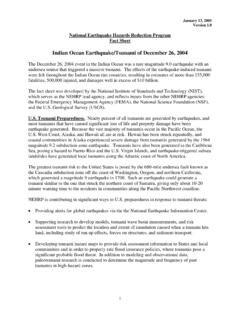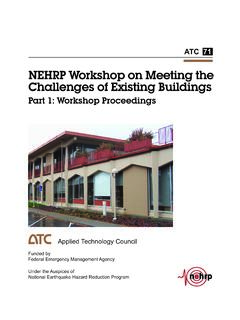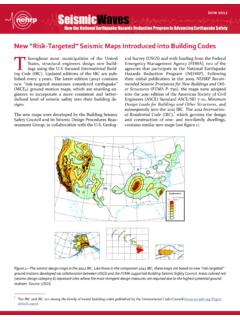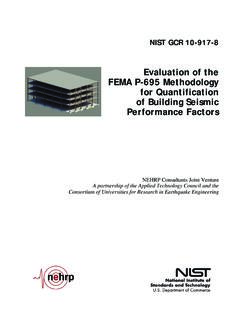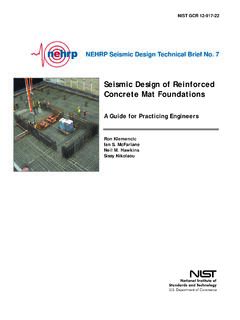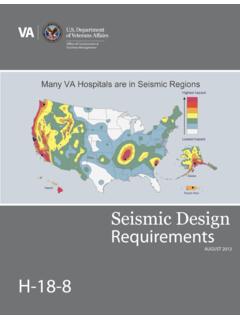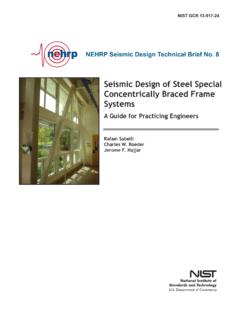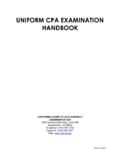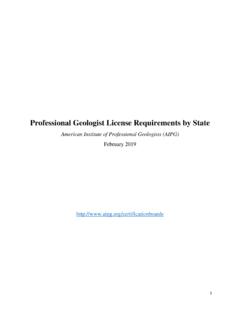Transcription of EVOLUTION OF CODES IN THE USA - NEHRP
1 EVOLUTION OF CODES IN THE USA Jim Rossberg* & Roberto T. Leon** * Structural Engineering Institute of ASCE Reston, VA 20191 (USA) **School of Civil and Environmental Engineering Georgia Tech, Atlanta, GA 30332-0355 (USA) Keywords: CODES , code development, standards, structural design, design loads Abstract: While harmonization of structural design CODES in Europe has been a detailed and organized process about to culminate in 2010 after 25 years of work, significant similar changes in American CODES occurred in the late 1990s and early 2000s through a completely different process. These changes included (1) the imposition of a single national code, where there had been three regional CODES before, (2) the formal separation between the load and resistance side of the CODES into a national load code and a series of material CODES , (3) the development and rapid adoption of ultimate strength design approaches for materials such as wood and masonry which had had only allowable strength design standards until recently, (4) the extensive editorial reorganization and changes in several CODES , and (5)
2 Extensive attempts at streamlining the inclusions of the latest research results into the CODES . The paper first traces the development of design CODES in the USA to provide a context for these recent developments. It then describes the regulatory environment that led to the adoption of a unified design code, including the selection between two competitive alternatives, the rationale behind some apparent random unification efforts, and the adoption process by the individual jurisdictions. Finally, this paper describes the new building code regulatory landscape and the first attempts at generating performance-based design guidelines, in the form of seismic provisions for tall buildings in high seismic zones.
3 1. Background to Development of CODES in the USA To comprehend the somewhat chaotic manner by which building CODES are developed in the United States, it is necessary to begin some 220 years ago or so with the ratification of the Bill of Rights to the US Constitution. At that time there was a great concern, bordering on fear, of establishing too strong of a national, centralized authority and so the 10th Amendment of the US Constitution clarified that powers not specifically granted to the Federal Government nor prohibited to the states by the Constitution are the dominion of the states or the people themselves.
4 As a result, the power to regulate design and construction of buildings has been left to the government of individual states, cities and towns. Over time individual cities developed and promulgated building CODES with the impetus usually being a major fire (1886 Chicago Fire) or natural disaster (1906 San Franciso Earthquake). Along this same time, insurance as a business began to come of age and the recognized need to provide for greater public safety and less payouts of insurance led to the founding in 1915 of the Building Officials and CODES Administrators, International (BOCA) and their subsequent issuing the first model building code which was based on a document used by insurance companies at the time.
5 Over time, two other model code organizations were established in the United States: (a) the Southern Building Code Congress International and (b) the International Conference of Building Officials. Each covered a distinct portion of the US based upon their membership, which consisted of the various jurisdictional building code departments (Figure 1.) It should be emphasized that all three were private corporations. Over the years each of these three organizations developed their own unique but similar processes for updating their model building CODES .
6 These CODES cover not just structural design but also plumbing, electrical, residential, fire CODES , and other design issues. The discussion herein is equally applicable to each of these, but only details related to structural design will be emphasized. Each organization published a new edition of their model CODES every three years, and the decision would then need to be made by each state or jurisdiction as to whether or not they wished to adopt it and update their own building code. It is this process at the state or local level whereby a building code in the US actually becomes law. The majority of states in the US do have building CODES that are promulgated by their state legislatures; however, the applicability of those CODES to the various jurisdictions within a state varies widely.
7 Often large cities, such as Chicago, New Orleans or New York, have their own building code that may or may not be consistent with the state building code. In addition, it is common for the final adoption authority to be left to an individual township Figure 1. Applicability of building CODES by region - pre-IBC. or county. Hence, it is not uncommon for large, typically rural, areas of a state to have no building code at all. 2. CODES AND STANDARDS When discussing building regulations in the United States it is important to recognize the differences but symbiotic relationship between CODES and standards.
8 Often used interchangeably, the two types of documents actually serve quite distinct purposes. A building code is the term referring to the legally adopted document by a jurisdiction for the purpose of regulating a portion of the design and construction industry in short, it is the law and hence must be adopted through the appropriate legislative process. The provisions of building CODES strive to address all aspects of the process including such areas as the approval process, the contents of the construction drawings, site preparation, loads, design, plumbing, mechanical, and electrical plans.
9 Conversely, standards provide in-depth provisions on a relatively small portion of the design and construction process. Because of the depth and expertise provided by the standard it is common for building CODES to adopt standards by reference in which case the use of the standard is legally required. It is this adoption by reference that causes standard developing organizations (SDO s) such as American Society of Civil Engineers (ASCE) to work closely with the developers of model CODES . If a SDO s standard is adopted by reference into the model code, there is a strong likelihood that this adoption will remain when the model is used by a jurisdiction to prepare their legally binding building code.
10 Another important distinction between CODES and standards is the manner in which they are developed. When a jurisdiction adopts or updates their building code they are essentially writing a law. Although the precise process varies by individual state or jurisdiction the steps are generally the same: a draft is prepared normally by a department within the government, the draft is accepted, reviewed and voted upon by a committee within the legislature, the committee approved version of the law is then submitted to the legislative branches for deliberation, and upon approval by the legislature, a final law is presented to the executive such as the governor for final approval.
